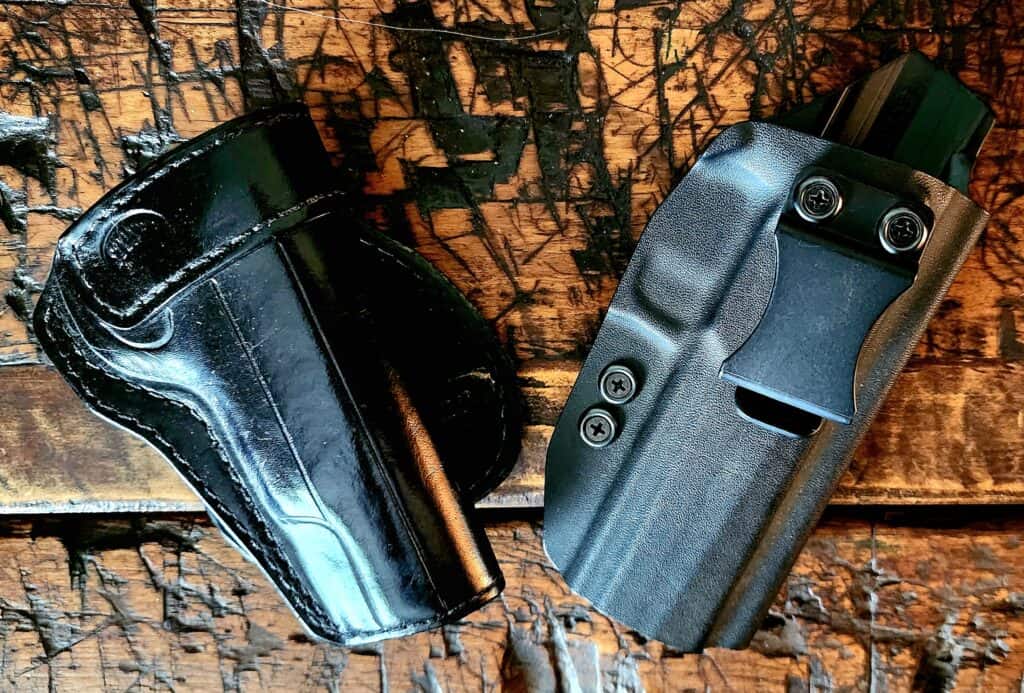When it comes to carrying a concealed firearm,selecting the right holster is paramount. Two popular options in the holster market are the Inside-the-Waistband (IWB) and the Outside-the-Waistband (OWB) holsters. Both offer distinct advantages and disadvantages, and it’s essential to consider your specific needs and preferences before making a decision. The purpose of this article is to explore the Pros and Cons of each to help you make an informed choice.

Inside-the-Waistband (IWB) Holsters
Pros:
- Enhanced Concealment: IWB holsters are worn inside the waistband ,making them an excellent choice for concealed carry. The positioning of the holster inside your pants helps to keep the firearm hidden under your clothing.minimizing the chance of printing or unintentional exposure.
- Comfortable and Discreet: IWB holsters typically provide a comfortable carry experience, as they distribute the weight of the firearm along the waistline. They are generally easy to conceal, making them suitable for everyday wear without drawing attention.
- Accessibility: allows for quick and efficient drawing. especially in a self-defense situations where every second counts.
Cons:
- Potential Discomfort: Depending on your body type, IWB holsters can sometimes cause discomfort due to the firearm pressing against your body. The bulk and weight of the gun can also create an awkward feeling when seated or bending.
- Clothing Limitations: IWB holsters may require you to adjust your clothing choices to accommodate the holster and ensure effective concealment. This may limit your wardrobe options or necessitate purchasing larger-sized pants.
Outside-theWaistband (OWB) Holsters
Pros:
- Comfort and Accessibility: OWB holsters are worn out side of the waistband, which can offer increased comfort compared to IWB holsters. The positioning allows for a more natural draw stroke, as there is no obstruction from clothing or waistband itself.
- Larger Firearms Options: OWB holsters typically accommodate larger firearms more easily, as they are not constrained by the waistband. This is especially beneficial for those who carry full-sized handguns or have specific requirements for their carry gun.
- Enhanced Ventilation: Wearing the holster on the outside of the waistband allows for improved airflow around the firearm, minimizing moisture buildup and potential corrosion.
Cons:
- Reduced Concealment: OWB holsters, due to their positioning, are more challenging to conceal compared to IWB holsters. The firearm may print or be more noticeable under certain clothing, making it less ideal for concealed carry in certain situations.
- Draw Attention: OWB holsters, even when concealed, may draw unwanted attention from individuals who are wary of firearms. This may be a concern if you prefer to keep your concealed carry status private.
- Limited Comfort for Certain Body Types: OWB holsters may be less comfortable for those with smaller body frames or who have a more pronounced waistline. The firearm’s bulk and the holster,s position could result in discomfort or an awkward fit.
Conclusion
Choosing between an IWB and a OWB holster ultimately depends on your personal preferences, body type, and the specific context in which you plan to carry. While IWB holsters excel in concealment and everyday wear, OWB holsters offer greater comfort and accessibility, especially for those who carry larger firearms. Consider your priorities, evaluate your clothing options and practice draw stroke with different holster types to determine which option aligns best with your needs. Ultimately, selecting a holster that ensures both firearm security and quick reliable access.